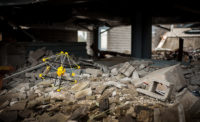Smart sensors. Convergence of technology. Internet-enabled devices. Analytics and informatics. Wired connectivity. Predictive monitoring. These words were not on the tip of industrial hygienists’ tongues even ten years ago.
But this past July, the American Industrial Hygiene Association invited 16 experts to the Sensor Technology Summit. In the September issue of the AIHA’s The Synergist, association President Steven Lacey, PhD, CIH, CSP, wrote in his editorial that advances in sensor technology have the “potential to fundamentally alter the way we do our work.” He echoed words NIOSH Director Dr. John Howard wrote in a NIOSH blog earlier this year: “The future of direct-reading devices and smartphone applications may help to revolutionize the practice of industrial hygiene and safety applications.”
Real-time detection
This past April, the AIHA published a 100-page report, “The Future of Sensors.” It talked of “a sensors renaissance” and “the rapidly changing sensor technology landscape.” Instruments in the field, either personal or area fixed monitors, now deliver real-time readings with multiple wireless connectivity options. An employee, for instance, can wear a multi-gas detector that not only alerts the individual to gas levels, but also transmits at the same time the gas level data through a wireless infrastructure (Wi-Fi, a cloud-based network, Bluetooth, the internet, radio frequency) to control center personnel. Monitoring is continuous, 24/7. In some applications, “man down” alerts (triggered by hand or a lack of motion) can be wirelessly transmitted to a remote control center, where an operator can pinpoint the location of the employee. Real-time data can include the identification of toxic chemicals, vapors, volatile organic compounds, dust and particulates, radiation, and plumes; a worker’s location; and physiological condition.
Exposure data analysts
No longer do industrial hygienists need to wait days to get results from a lab to determine if exposures warrant a worker wearing a respirator. Exposure peaks can be studied by location and time. Wrote Lacey in his editorial: “We could potentially have far more information than we ever imagined. How do we manage the sheer volume of data? Will field sampling be redefined as practitioners focus on becoming ‘exposure data analysts’, as John Howard asked at AIHce 2014 in San Antonio?”
Talk about data analysts, Politico recently reported Hillary Clinton’s presidential campaign team employs more than 60 mathematicians and analysts, “something of the central nervous system for the campaign: charged with sensing, even predicting, the first tinglings of electoral trouble and then sending instructions to everyone on how to respond.”
That’s the workload landslide Big Data can generate.
The Big Data boom
How will industrial hygienists manage Big Data and the Industrial Internet of Things? By 2020, an estimated 50 billion devices will be connected to the Internet of Things, according to a report by Cisco and DHL. This barrage of connectivity to everything from drones, smart homes, wearables, embedded textiles, fleet vehicles to healthcare patients, solar panels, jet engines and industrial machinery holds the promise of unearthing and analyzing data in unheard-of ways. Industrial hygienists and safety professionals will be working in real-time rather than looking through the rear-view mirror, conducting on-the-spot proactive computing rather than reactive computing.
Professional reactions
Several industrial hygienists contacted by ISHN are not concerned about being buried in data. Says Mark Katchen, CIH: “IHs are used to analyzing data and many instruments have datalogging capabilities, some with graphical representations to see exposure patterns quickly. These instruments come with software making that analysis pretty easy. There might be a knowledge gap, depending on the level of training, with using slightly more sophisticated statistical packages.”
Says another: “Everyone is strapped for in-house resources, except perhaps the pharmaceutical industry and the oil and gas industry. I would expect that most other companies would get the analytics done by external sources, just as most corporate IH functions already use outsourced consultants to do their IH monitoring and rely on them to provide the data.”
“If detectors can sense and analyze data real time against some predetermined yardsticks/standards, it might be OK as a screening mechanism,” says Chris Laszcz-Davis, CIH. “The challenge will be agreeing on the predetermined yardstick or mathematical model.”
Indeed, using modeling and informatics for improved decision-making are important areas to study, according to a survey of IHs conducted by the AIHA. Finding the necessary funds to acquire the technology and a current lack of knowledge and awareness about advancing technology are the biggest barriers to use, according to the survey.
“It goes without saying this is the next evolution of data-gathering and interpretation, but it’s pretty early on.” says Laszcz-Davis. IH professionals know today’s economy is ramped up to produce more advanced sensors for more applications; they know that to best protect worker health, pros need to be actively engaged in developments, not passively react.










